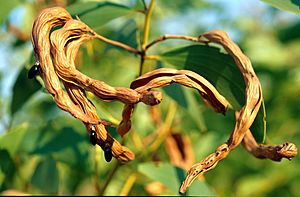Acacia tumida facts for kids
Quick facts for kids Acacia tumida |
|
|---|---|
 |
|
| Acacia tumida seed pods | |
| Scientific classification | |
| Genus: |
Acacia
|
| Species: |
tumida
|
 |
|
| Occurrence data from AVH | |
| Synonyms | |
|
Racosperma tumidum (F.Muell. ex Benth.) Pedley |
|
Acacia tumida, also known as pindan wattle, spear wattle, or wongai, is a type of Acacia tree or shrub. It grows naturally in northern and western Australia.
Contents
About the Pindan Wattle
The Acacia tumida is usually a spreading tree or shrub that can grow quite tall, from about 5 to 15 meters (16 to 49 feet). It has a wide, well-developed top, called a canopy. The bark is hard, grey, and shiny, sometimes with cracks. Its younger branches are often orange to yellow and look like they have a powdery coating.
Its leaves are actually flattened leaf stalks called phyllodes. These phyllodes are curved like a sickle (falcate) and have a blue-green color. They can be from 6 to 25 centimeters (2 to 10 inches) long and 0.7 to 6 centimeters (0.3 to 2.4 inches) wide.
This plant produces yellow flowers, usually in long clusters called inflorescences, between April and October. These flower clusters can be up to 20 centimeters (7.9 inches) long and grow from the leaf joints or at the ends of branches. After the flowers, narrow, woody, smooth seed pods grow. These pods are 3 to 12 centimeters (1.2 to 4.7 inches) long and contain shiny black seeds.
Acacia tumida grows quickly, but it doesn't live very long, usually less than 10 years.
Where it Grows
Acacia tumida is found in many parts of Western Australia, including the Kimberley, Pilbara, and the northeastern Goldfields regions. It also grows across much of the Great Sandy Desert. You can also find it in the Victoria River district of the Northern Territory.
This plant grows well in sandy areas, especially in red sandy soils or a type of soil called pindan soil, which is often found over sandstone. It often forms thick groups with spinifex grasses.
Beyond Australia, Acacia tumida is also grown in countries like Yemen, Vietnam, Senegal, and Niger.
Different Types of Acacia tumida
There are four known types, or varieties, of Acacia tumida. These varieties are slightly different from each other, perhaps in their size, shape, or where they grow.
- Acacia tumida var. extensis
- Acacia tumida var. kulparn
- Acacia tumida var. pilbarensis
- Acacia tumida var. tumida
How People Use Acacia tumida
Aboriginal people have traditionally used the Acacia tumida tree in many ways. They used the trunks of young trees to make tools like spears and boomerangs.
The green seed pods were cooked over hot coals, and then the seeds inside were eaten. When the seeds were fully ripe and black, they were ground into flour. This flour could be mixed with water to make a paste or cooked like a type of bread called damper. People also made strong string from the bark of the tree. The sticky sap that comes out of the tree, called gum, was also eaten as a food source.
In countries like Senegal and Niger, Acacia tumida is grown for its wood, which makes good quality firewood. It is also used to create low windbreaks, which help protect land from strong winds. Because it helps hold soil together, it's often planted with other slower-growing plants to prevent soil from washing away.

